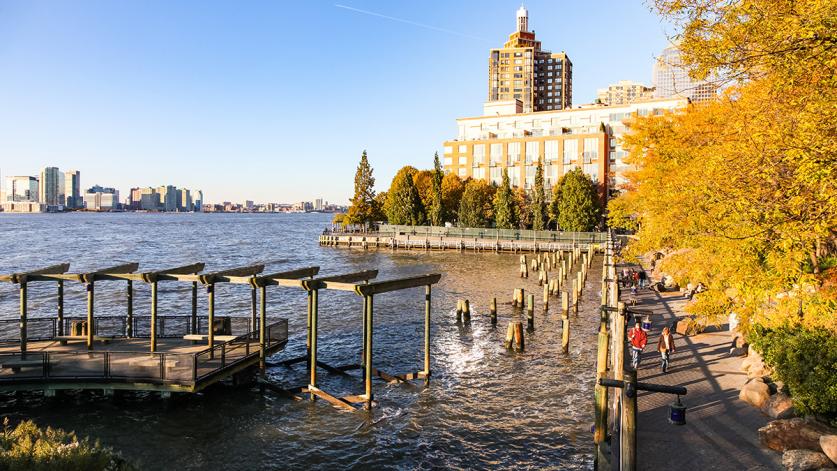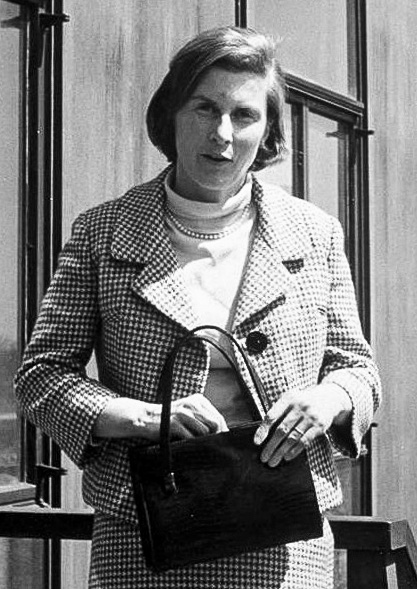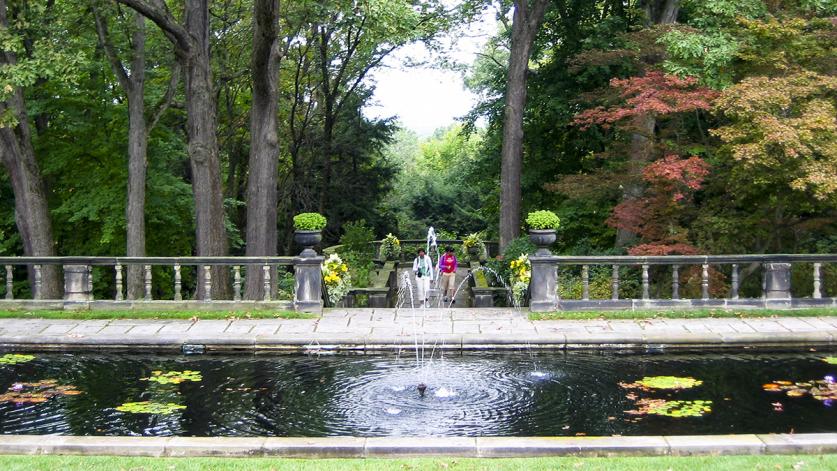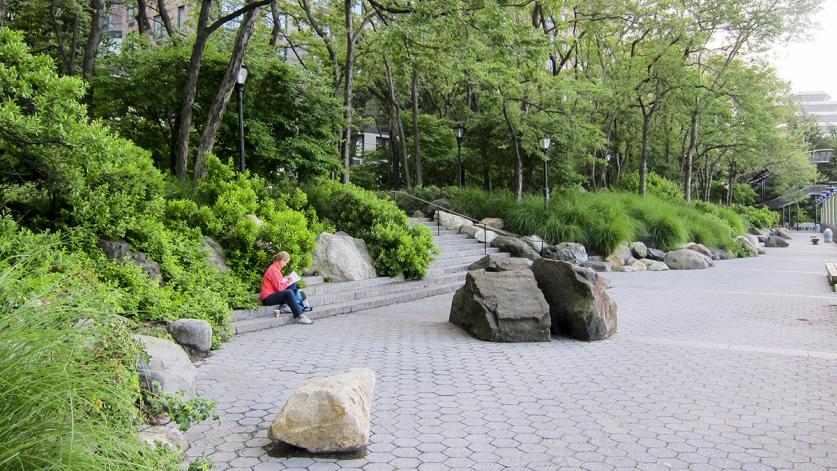Susan Ryan 1985 Art and Design Graduating Class of 1985
Child spent the early years of her life in New England. Her involvement in landscape architecture developed from her passion for art, gardening, and history, as well every bit time spent at her family's farm in southeastern Massachusetts. Child received her B.A. from Vassar College in 1950 with a concentration in art history and French. She and so focused on raising her family unit and advocating for urban gardening before receiving her graduate document in landscape and environmental design at the Radcliffe Institute in 1975. In 1978 she enrolled in the landscape compages program at Harvard's Graduate School of Blueprint, where she was mentored by then-department head Peter Walker.
Child graduated from Harvard in 1981 and founded Child, Hornbeck Associates, Inc., in Boston with former professor Peter Hornbeck. Following Hornbeck'southward departure in 1984, she founded Child Associates Inc., Mural Architecture, with Douglas Reed. Together they shaped a firm that successfully completed a great diverseness of project types. Child is all-time known for her conceptual clarity in design, emphasis on rigorous documentary research, knowledge of plants, and ability to design thoughtful spatial experiences – attributes that influenced such colleagues every bit Duncan Alford, Anita Berrizbeitia, and Chris Moyles, among others. The firm's piece of work includes the publicly accessible State Place-era estate Stan Hywet Hall in Akron, Ohio (1984); Richmond Garden, a private rural retreat in the Berkshires of western Massachusetts (1986-1988); and Due south Cove, a waterfront park at Battery Park City, New York (1985-1989), regarded as her well-nigh significant blueprint. There she collaborated with artist Mary Miss and architect Stan Eckstut to arts and crafts a sculptural mural that carefully addressed the relationship betwixt urban center and the river's edge. Child was inducted equally a Boyfriend of the American Society of Landscape Architects in 2011. She died at her domicile in New Haven, Connecticut, on November thirteen, 2018.
Born in 1928, Susan Child came to the profession of landscape architecture later in life, after raising a family and working equally an advocate for urban gardening. A longtime resident of New England, Child graduated from Vassar College in 1950 with extensive coursework in art history and French. She so moved to Boston and immersed herself in various societies defended to the appreciation of art, gardening, and civilisation, serving on the Board of Trustees for multiple organizations. With her family unit, she frequently vacationed to and gardened on a subcontract forth the estuary of the Westport River in southeastern Massachusetts that was created past her father-in-police Josiah Child, an architect trained at the École des Beaux-Arts in Paris. The family unit subcontract was an important influence on her life and design work, and Kid cites it equally having the deepest impression on her sensitivity to the congenital environment.
Afterwards 20 years dedicated to community and family, Kid pursued her allied interests in gardening and art through a graduate certificate in landscape and ecology design at the Radcliffe Institute, graduating in 1975. At Radcliffe, a grade by Diane McGuire on the "Intellectual History of Garden Art" was specially influential, an early incubator of Child's historically witting and theoretically-motivated design perspective.
Kid worked for the City of Boston from 1975 to 1978 as projection manager with the mayor'south program for Revitalization of Vacant Lots (REVIVAL) and "The Greening of Boston" Neighborhood Improvement Program, too as coordinating many Parks and Recreation Section projects. Working in the public sector, oft with an emphasis on urban horticulture, was a natural expansion of her talents and imparted an important collaborative ethic on Child, yet she longed for a greater focus on the art of pattern. In 1978 she enrolled in the Harvard Graduate School of Design (GSD) Master in Landscape Architecture program. At the GSD, Kid found a mentor in then-department head Peter Walker. Her background in art history allowed Child to appreciate Walker'southward perspective of landscape as fine art and his emphasis on theoretical approaches to design, both of which were highly influential on her career and are visibly present in her later do. During her second year at Harvard, an exhibition on the work of Dan Kiley, "Modernistic Classicist," which captured the landscape builder'due south clarity, logic, and rational ordering of space, inspired Kid and informed her subsequent pattern ethos.
Upon graduation in 1981 Child partnered with Harvard professor Peter Hornbeck to found the mural architecture firm Child, Hornbeck Associates, Inc, in Boston. Within months, Douglas Reed, whom Child had met as a classmate at Harvard, joined the firm, kickoff as an associate and later as a partner when Hornbeck departed in 1984 (at which betoken the firm became Child Associates, Inc., Mural Architecture). Child's ability to conceptualize landscape, describe from precedent, and employ minimal means in her expression of place influenced numerous colleagues, including Reed, Duncan Alford, Anita Berrizbeitia, Chris Moyles, and John Grove, among others.
One of the firm'south showtime major commissions was the 1984 plan for the restoration of Stan Hywet Hall in Akron, Ohio, a 70-acre manor originally designed by Warren Manning that had fallen into disrepair. Through a review of express historic documentation, oral histories of family members, and intense study of existing site evidence, Child Assembly extracted the essence of its early on twentieth century Country Place era design, and situated Stan Hywet as 1 of Manning's about significant residential works. Child noted the necessity of research and incorporating celebrated precedent in their celebrated preservation work, "not as replication merely every bit a source of inspiration or possible metaphor," to basis the work in a larger cultural narrative. Stan Hywet Hall was the first of many historic designed landscapes that Child Associates approached in this way, including: D.Westward. Field Park, Brockton, MA (1985-1989); Weir Farm, Wilton, CT (1992-1997); and Franklin Park, Boston, MA (1995-1998).
Kid's magnum opus, Southward Cove at Battery Park in New York Metropolis (1985-1989), was a collaborative effort with artist Mary Miss and architect Stan Eckstut, a team assembled under the direction of the Battery Park City Authority's Amanda Brunt and Thomas Kozlowski, whom Kid and Reed had met at the GSD. Eckstut, with his firm, Cooper Robertson Eckstut, adult the master plan of Battery Park City. Miss' sculptural urban site intervention work was compatible with Child's fascination with landscape as "art at the service of people." Challenged to design a iii ½-acre park on a physical platform suspended over landfill at the river's border, the pattern squad treated the landscape as a sculptural installation. Off the main promenade of Battery Park City, the design incorporates a lower walkway close to the water's peak defined past an undulating planted landform, while graduated wood pilings extend into the h2o in reference to a maritime past. The relationship between city and river'southward edge was carefully crafted through vertically layered spaces that unfold sequentially, while indigenous plantings and rock outcroppings recall natural coves of the Northeast.
Kid farther established her reputation through a serial of residential projects in the 1980s and early 1990s that all exemplify her creative sensibility towards landscape. At Richmond Garden (1986-1988) in the Berkshire Hills of Massachusetts, Child Associates employed a deep understanding of rural simplicity to restore the connection between a vacation house and its surrounding mural. The Grand Isle Residence (1988-1991) on Lake Champlain, Vermont, united sundry mural elements through a series of forest structures—stepped platforms, pavilions, and boardwalks deployed at places of unusual topographical and botanical interest—which choreographed a sequence of views and relationships between the individual and the broader landscape.
Kid's legacy endures as much in her sensitivity to materials as in her emphasis on spatial feel. She was a masterful horticulturist with a vast knowledge of plants and 30 years of gardening experience, oftentimes employing unexpected plants in unorthodox places. For instance, at S Cove, multi-stemmed dear locusts dot the landscape's dune-similar topography, and a visually dominant yet physically inaccessible island harbors groundsel shrub, capturing a familiar image of stagnant shorelines.
Child received numerous awards in recognition of her work. Within ten years of graduating from Harvard, her firm garnered thirteen National Design Awards from the American Society of Mural Architects (ASLA). She was inducted as a Fellow of the ASLA in 2011. She lectured widely at symposia and schools of design throughout her career, inspiring her students and the public with a compelling narrative of design. Susan Kid died at her home in New Oasis, Connecticut, on Nov 13, 2018.
Publications
Griswold, Mac. "Simple Gifts." Garden Design 12, no. 5 (1993): 40-47.
Provides an overview of Child's design perspective while briefly highlighting three projects: Richmond Residence, Siasconset Residence, and Troy Residence.
Kid, Susan. "Near Influential Landscapes." Mural Journal 12 (Fall 1993): 187.
Q&A with prominent mural architects; Child discusses farmland along the estuary of the Westport River, Dan Kiley's Miller Garden, and the Italian Renaissance Villa.
Trulove, James Grayson. The New American Garden: Innovations in Residential Landscape Compages. New York: Whitney Library of Design, 1998: 36-49.
Includes photos and short descriptions of the Kid-designed Richmond Garden, Nantucket Residence, Thou Isle Residence, and Troy Residence.
Kirkwood, Niall. "Abstracting Nature's Details: a planted path forth a cove."The Art of Landscape Item. New York: John Wiley & Sons, 1999: 294-306.
Interview with Susan Child on the blueprint and construction of South Cove at Bombardment Park Metropolis.
Source: https://www.tclf.org/susan-child





0 Response to "Susan Ryan 1985 Art and Design Graduating Class of 1985"
Enregistrer un commentaire